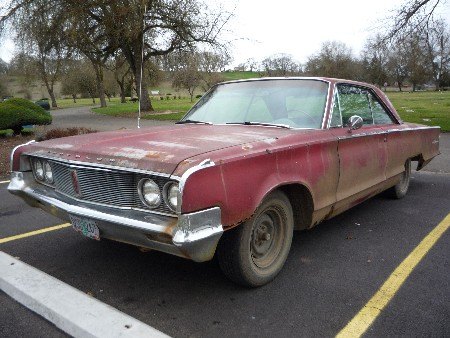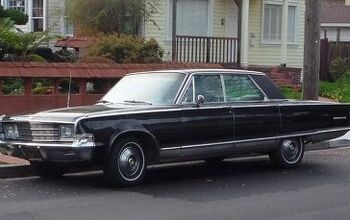Curbside Classics: 1965 Chrysler Newport

Fate intervened. I wasn’t going to do another Chrysler product CC for a while, after the two recent Plymouths. But there I was tooling down West 11th when I spotted this red Chrysler up ahead. When I finally got next to him at a light, I waved my camera and gestured if he would pull over for a shoot. A nod of assent followed. But he kept burbling along, and I began to wonder. Suddenly, he pulled into the Lane Memorial Gardens. How fitting.
Especially so since his majestically beautiful 1965 Newport hardtop coupe looks like it has one foot in the grave already. We just don’t see rust like this in this part of the world. The owner said something about it being a “beach car.” I have a different theory.
Studies say that long-time married folks begin to look more like each other. This guy and his car have been soul mates for many decades, and his car is just trying to look like him: a grizzled, hacking, chain-smoking old tough. And the cancerous rust is just the outer manifestation of the state of his lungs. Anyway, you could tell these two were bonded for life and in an unspoken race to see who would end up in the graveyard last. I wouldn’t bet against the Chrysler.
The second half of the sixties was a golden era for Chrysler, perhaps its best after its glorious debut in the twenties. It finally slew the twin dragons of quirky styling and lingering questions of build quality. Good thing, too.
The flamboyant designer Virgil Exner was hired in the early fifties to solve Chrysler’s stodginess problem. His early efforts were exemplary hits, like the superb 1955 Chrysler 300, as well as its over-the top follow-up, the ’ 57 300 C. But Ex had a tendency to go out of the mainstream of popular taste, like the 1960 Valiant. Technically superior, Valiant sales struggled under the weight of its eccentricity and that fake spare tire.
But the downsized 1962 Plymouths and Dodges were the last straw. Exner was shown the door, and Elwood Engel, the father of the superb (and restrained) 1961 Continental and 1961 T-Bird, was hired away from Ford.
Engel (obviously) was a lover of classic proportions, formal roof-lines, and slab sides punctuated by chrome accents. And his first assignment at Chrysler, the ill-fated Turbine concept has T-Bird written all over it.
The 1965 full-size Mopars were the first production cars with Engel’s signature on them. The Chryslers were the best of the bunch. And Plymouth was mighty happy just to have a full-sized car again. Chrysler sales swelled to over 200k, with the entry-level Newport leading the charge. A handsome car indeed, although its slab-sided edginess made it an outsider from the start, thanks to GM’s tectonic shift to coke-bottle styling in 1965.
But Chrysler’s reputation (back then) was almost always greater for what happened under the skin. It’s torsion bar suspensions weren’t quite as floaty as GM and Ford’s. Brakes were taken a bit more seriously. Engines were all solid, and the TorqueFlite slushbox was the most efficient and reliable in the land. Chrysler’s power steering was effortless but notoriously devoid of feeling. Oh well.
Chryslers tended to appeal to those that still saw a car as an engineered device, rather than a styled appliance or status symbol. In my family’s circle of Germanic-academic immigrant types, Chryslers were the car of choice, especially after Studebaker bit the dust (it was that Mercedes connection). Of course, by the mid-seventies they were buying the real thing (Mercedes, that is). But when this battered but still-proud Newport was box-fresh, it spoke well of its buyer: independent, intelligent and successful. Well, the mid-sixties were a long time ago.
Due to my father’s irrepressible modesty, our family Mopar was a lowly ’65 Dodge Coronet wagon. But his cousin, a traveling salesman of fine German optics, was a real car guy. Always drove in style and had a fine eye for quality.
He first drove a gorgeous powder-blue 1962 Caddy Fleetwood. But it was not with out its vices, and a traveling salesman can’t afford breakdowns. He traded it in for a four door ’65 Newport. With the 315-horsepower four-barrel 383, it was a more-reliable way to get him to the next small-town camera shop in speed, comfort and style. That is, until he traded that it in for a 1969 Mercedes 280SE. I saw the writing on Detroit’s wall a long time ago.
Meanwhile, this pair of old vets will keep rolling along, oblivious to the tattered shreds of their fenders and lungs. In their hearts beats the pride of a glorious past and a healthy, burbling 383. It wouldn’t surprise me if they both outlive the New, New Chrysler.

More by Paul Niedermeyer
Latest Car Reviews
Read moreLatest Product Reviews
Read moreRecent Comments
- Dave Holzman My '08 Civic (stick, 159k on the clock) is my favorite car that I've ever owned. If I had to choose between the current Civic and Corolla, I'd test drive 'em (with stick), and see how they felt. But I'd be approaching this choice partial to the Civic. I would not want any sort of automatic transmission, or the turbo engine.
- Merc190 I would say Civic Si all the way if it still revved to 8300 rpm with no turbo. But nowadays I would pick the Corolla because I think they have a more clear idea on their respective models identity and mission. I also believe Toyota has a higher standard for quality.
- Dave Holzman I think we're mixing up a few things here. I won't swear to it, but I'd be damned surprised if they were putting fire retardant in the seats of any cars from the '50s, or even the '60s. I can't quite conjure up the new car smell of the '57 Chevy my parents bought on October 17th of that year... but I could do so--vividly--until the last five years or so. I loved that scent, and when I smelled it, I could see the snow on Hollis Street in Cambridge Mass, as one or the other parent got ready to drive me to nursery school, and I could remember staring up at the sky on Christmas Eve, 1957, wondering if I might see Santa Claus flying overhead in his sleigh. No, I don't think the fire retardant on the foam in the seats of 21st (and maybe late 20th) century cars has anything to do with new car smell. (That doesn't mean new car small lacked toxicity--it probably had some.)
- ToolGuy Is this a website or a podcast with homework? You want me to answer the QOTD before I listen to the podcast? Last time I worked on one of our vehicles (2010 RAV4 2.5L L4) was this past week -- replaced the right front passenger window regulator (only problem turned out to be two loose screws, but went ahead and installed the new part), replaced a bulb in the dash, finally ordered new upper dash finishers (non-OEM) because I cracked one of them ~2 years ago.Looked at the mileage (157K) and scratched my head and proactively ordered plugs, coils, PCV valve, air filter and a spare oil filter, plus a new oil filter housing (for the weirdo cartridge-type filter). Those might go in tomorrow. Is this interesting to you? It ain't that interesting to me. 😉The more intriguing part to me, is I have noticed some 'blowby' (but is it) when the oil filler cap is removed which I don't think was there before. But of course I'm old and forgetful. Is it worth doing a compression test? Leakdown test? Perhaps if a guy were already replacing the plugs...
- Crown No surprise there. The toxic chemical stew of outgassing.






































Comments
Join the conversation
What grand old cars. I actually think that those Valiants were so fugly that they were cute. My friends' cousin had a wagon with the push button auto-transmission. At the time it was no big deal but looking back we were riding in greatness. Oh what a sad time it is. Hoping some new class arrives
Memories of my Grandpa's 1965 Newport sedan have come flooding back. Aquamarine with matching cloth-and-vinyl interior. I loved the hum of the 440 engine. Whenever I heard that sound, I knew my grandparents were showing up, and I dutifully prepared myself to be spoiled. Wow. At one time, Chrysler actually built nice cars.